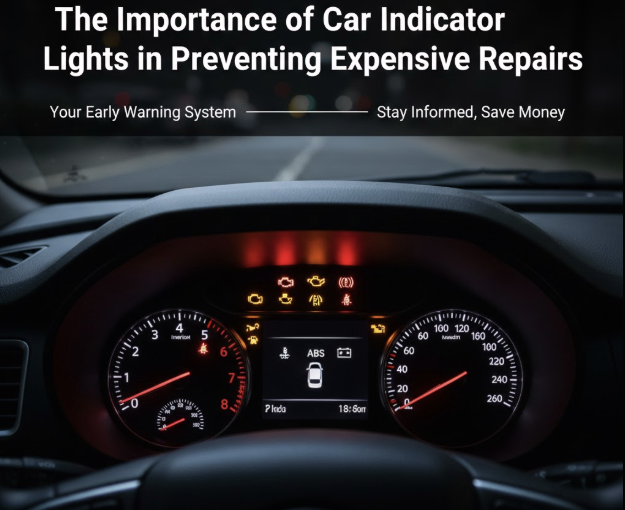Car indicator lights are often the first line of defense when it comes to preventing expensive car repairs. These lights alert you to potential issues before they turn into costly problems, giving you the opportunity to take action before a minor inconvenience becomes a major repair. From the engine light symbol to warnings about the brake service or suspension repair, understanding the significance of these lights is crucial for maintaining the health of your vehicle. In this article, we’ll explore the importance of car indicator lights, what each light signifies, and how addressing them promptly can save you from unnecessary repair bills.
What Are Car Indicator Lights?
Car indicator lights are visual signals on your vehicle’s dashboard that communicate the status of different systems in your car. These lights are typically color-coded—green or blue for normal operation, yellow or orange for caution, and red for urgent issues that require immediate attention. While many drivers ignore these lights, doing so can lead to significant issues, potentially causing extensive damage to your vehicle. These lights are there for a reason: to help you identify issues early and avoid expensive repairs. To learn more about Car Dashboard Symbols and Meanings, you can checkout this blog: Your Guide to Car Dashboard Lights | Applewood Auto Care.
Table of Contents
ToggleCommon Car Indicator Lights and Their Importance
1. The Engine Light Symbol
The engine light symbol is perhaps one of the most commonly seen warning lights on modern dashboards. This light can indicate a range of problems, from something as minor as a loose gas cap to more serious issues such as a malfunctioning sensor, a misfire, or problems with the exhaust system. If the light is solid, it usually means there’s a non-urgent issue, but if it’s flashing, it indicates a more severe problem that could lead to engine damage.
Why It’s Important:
Ignoring the engine light symbol could lead to more severe damage to your car’s engine, which would result in expensive repairs. Taking the car to a trusted repair shop in Lakewood or elsewhere as soon as possible for diagnostics can prevent the issue from becoming worse. Whether the problem is related to your transmission cooler lines, fuel system, or something else, early detection can save you a lot of time and money.
- Brake Service Light
The brake system is one of the most important safety features of any vehicle. The brake service light indicates that there is an issue with your braking system, whether it’s with the brake pads, fluid levels, or more serious components like the brake rotors or calipers. This light can also signal that your brake fluid is low or there is air in the brake lines.
Why It’s Important:
Ignoring the brake service light can lead to major safety risks and expensive repairs. For instance, worn-out brake pads, if not replaced, can cause damage to the brake rotors, which are far more expensive to replace. Timely attention to this light can prevent further damage and ensure your brakes are in optimal condition, keeping you safe on the road and saving you the cost of costly repairs.
- Suspension Repair Warning Light
The suspension system is vital for maintaining vehicle stability and comfort. A suspension repair light may appear when there is an issue with the shocks, struts, or other suspension components. This light may also signal problems with your tires or alignment.
Why It’s Important:
Ignoring suspension problems can lead to more serious issues such as uneven tire wear, poor handling, or even accidents. Early diagnosis and suspension repair can save you from expensive tire replacements and alignment issues, ensuring your car handles properly and smoothly. Routine suspension checks can prevent these costly repairs from piling up.
- Transmission Fluid Warning Light
Transmission issues can be among the most expensive repairs for a car owner. The transmission fluid warning light typically comes on when there is low fluid or a problem with the transmission system. This could be due to a leak, a damaged transmission cooler line, or a failing transmission pump.
Why It’s Important:
Transmission repairs are often very costly, so catching an issue early can save you thousands of dollars in repairs. Low transmission fluid can cause your transmission to overheat or fail, leading to a complete transmission replacement. If you notice the transmission warning light, have your car checked immediately, especially if you suspect issues with your transmission cooler lines.
- Tire Pressure Monitoring System (TPMS)
The TPMS light indicates that one or more of your tires is underinflated. Low tire pressure can affect fuel efficiency, handling, and safety. This light is usually orange or yellow and should not be ignored.
Why It’s Important:
Driving on underinflated tires not only reduces fuel efficiency but can also cause uneven tire wear, potentially leading to a blowout or other costly tire-related issues. Checking and maintaining proper tire pressure can extend the lifespan of your tires and improve your car’s handling, saving you money on premature tire replacements.
How Car Indicator Lights Prevent Expensive Repairs
Car indicator lights are designed to help you detect issues early, preventing them from escalating into major problems. Addressing these problems at the first sign can save you a significant amount of money in repairs. Here are a few ways in which these lights help:
- Early Detection of Issues
Most car indicator lights signal issues while they are still minor and can be fixed inexpensively. For example, a small leak in the transmission cooler lines might cause the transmission fluid level to drop, triggering a warning light. Fixing this issue early could cost only a few hundred dollars, but if left unchecked, it could lead to a complete transmission failure, costing thousands.
- Preventing Further Damage
Ignoring warning lights can lead to further damage in other systems of your vehicle. A simple brake issue, such as worn-out brake pads, can cause damage to your rotors if left unaddressed. Rotors are far more expensive to replace than brake pads, meaning that ignoring the brake service light could result in a much higher repair bill.
- Improving Vehicle Safety
Indicator lights are not just about saving money—they’re about protecting your safety. Brake issues, suspension problems, and engine malfunctions can compromise your car’s ability to perform properly. For example, driving with faulty brakes can result in accidents, and ignoring suspension issues can lead to poor handling and instability, especially on rough or uneven roads.
- Cost-Effective Maintenance
By addressing small issues early, you are engaging in proactive maintenance that keeps your car in top shape. Regular maintenance checks prompted by warning lights will help avoid larger repairs in the future. Whether it’s getting a suspension repair or checking transmission cooler lines, routine inspections save you from paying for major repairs that could have been avoided with early attention.
When to Seek Auto Repair Services
While some indicator lights may be minor, others signal issues that require immediate attention. Here’s when to seek professional auto repair services:
- Flashing Engine Light Symbol: If the engine light symbol is flashing, it indicates a serious issue such as an engine misfire. This should be addressed immediately by a professional mechanic.
- Brake Service Light: If your brake service light comes on, don’t delay. Your brakes are a critical safety feature, and any issues should be resolved right away.
- Transmission Fluid Warning: Low or leaking transmission fluid can lead to serious transmission damage. Get your car to a trusted repair shop as soon as possible.
- Suspension Repair: If your car shows signs of suspension issues, such as poor handling, loud noises, or uneven tire wear, schedule a suspension repair to ensure your car is safe and comfortable to drive.
- Tire Pressure Warning: Always check tire pressure immediately when the TPMS light appears. Low tire pressure can lead to unsafe driving conditions and tire damage.
How to Ensure Your Car’s Indicator Lights Are Always in Working Condition
Your car’s indicator lights are a crucial part of your vehicle’s warning system, so it’s essential to keep them functioning properly. Here are a few tips to ensure they’re working:
- Check the Light Bulbs: Ensure that all dashboard lights are functional. If a light doesn’t appear when you start your car, it might need a new bulb.
- Regular Maintenance: Have your car’s systems checked regularly. Routine oil changes, brake checks, and suspension inspections will ensure that your vehicle remains in good shape.
- Check for Leaks: Periodically check your car’s fluids to make sure there are no leaks in the system, especially in areas like the transmission cooler lines.
Conclusion
Car indicator lights are an essential feature of modern vehicles, designed to alert you to potential issues before they become major, expensive repairs. Whether it’s the engine light symbol, the brake service light, or the suspension repair light, taking action when a light appears can save you significant money in the long run. Don’t wait for a small issue to turn into a costly repair. Stay proactive and visit a trusted repair shop in Lakewood or your local mechanic for timely diagnostics and repairs. Early attention to these lights ensures that your car remains in top condition, running safely and efficiently for years to come.









